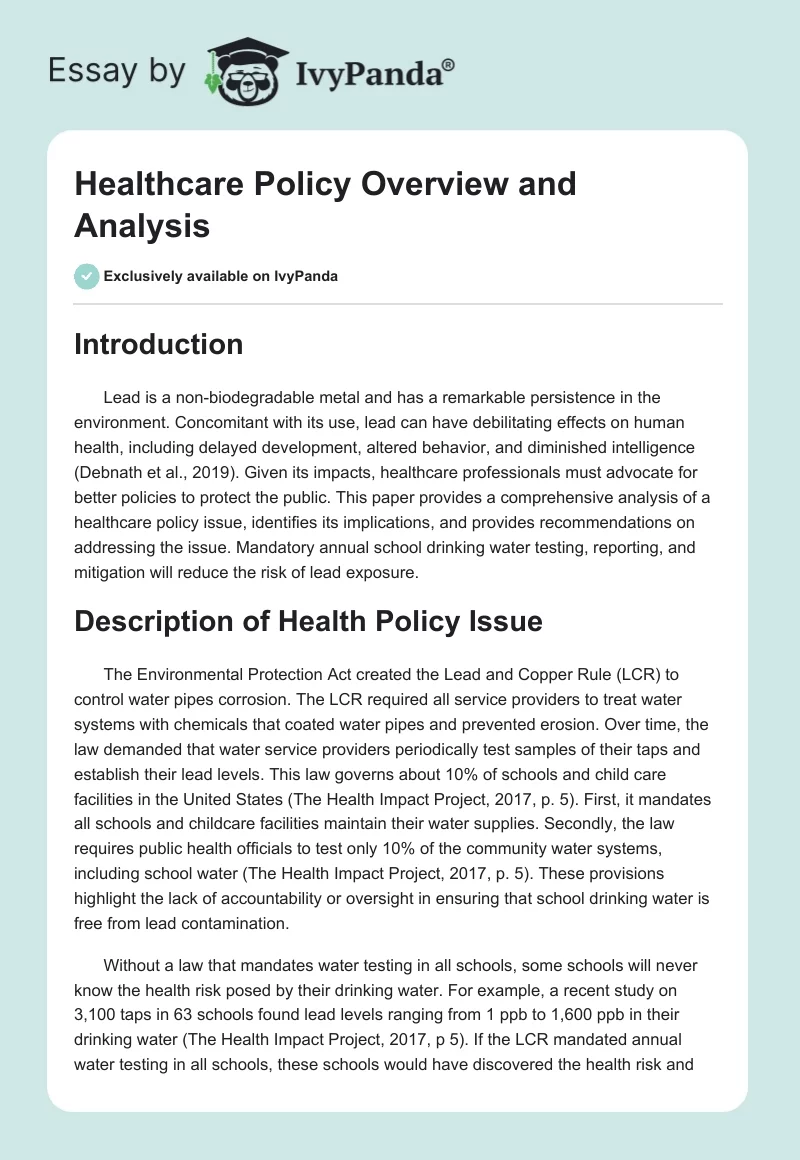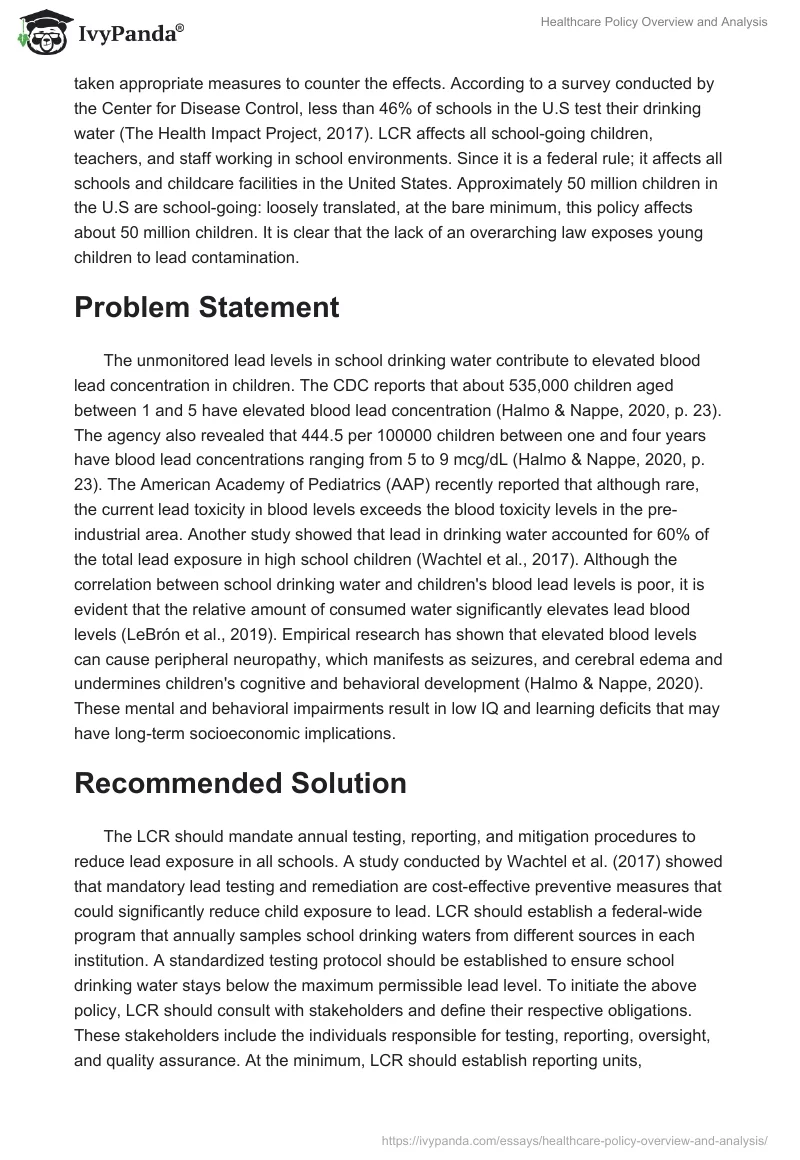Introduction
Lead is a non-biodegradable metal and has a remarkable persistence in the environment. Concomitant with its use, lead can have debilitating effects on human health, including delayed development, altered behavior, and diminished intelligence (Debnath et al., 2019). Given its impacts, healthcare professionals must advocate for better policies to protect the public. This paper provides a comprehensive analysis of a healthcare policy issue, identifies its implications, and provides recommendations on addressing the issue. Mandatory annual school drinking water testing, reporting, and mitigation will reduce the risk of lead exposure.
Description of Health Policy Issue
The Environmental Protection Act created the Lead and Copper Rule (LCR) to control water pipes corrosion. The LCR required all service providers to treat water systems with chemicals that coated water pipes and prevented erosion. Over time, the law demanded that water service providers periodically test samples of their taps and establish their lead levels. This law governs about 10% of schools and child care facilities in the United States (The Health Impact Project, 2017, p. 5). First, it mandates all schools and childcare facilities maintain their water supplies. Secondly, the law requires public health officials to test only 10% of the community water systems, including school water (The Health Impact Project, 2017, p. 5). These provisions highlight the lack of accountability or oversight in ensuring that school drinking water is free from lead contamination.
Without a law that mandates water testing in all schools, some schools will never know the health risk posed by their drinking water. For example, a recent study on 3,100 taps in 63 schools found lead levels ranging from 1 ppb to 1,600 ppb in their drinking water (The Health Impact Project, 2017, p 5). If the LCR mandated annual water testing in all schools, these schools would have discovered the health risk and taken appropriate measures to counter the effects. According to a survey conducted by the Center for Disease Control, less than 46% of schools in the U.S test their drinking water (The Health Impact Project, 2017). LCR affects all school-going children, teachers, and staff working in school environments. Since it is a federal rule; it affects all schools and childcare facilities in the United States. Approximately 50 million children in the U.S are school-going: loosely translated, at the bare minimum, this policy affects about 50 million children. It is clear that the lack of an overarching law exposes young children to lead contamination.
Problem Statement
The unmonitored lead levels in school drinking water contribute to elevated blood lead concentration in children. The CDC reports that about 535,000 children aged between 1 and 5 have elevated blood lead concentration (Halmo & Nappe, 2020, p. 23). The agency also revealed that 444.5 per 100000 children between one and four years have blood lead concentrations ranging from 5 to 9 mcg/dL (Halmo & Nappe, 2020, p. 23). The American Academy of Pediatrics (AAP) recently reported that although rare, the current lead toxicity in blood levels exceeds the blood toxicity levels in the pre-industrial area. Another study showed that lead in drinking water accounted for 60% of the total lead exposure in high school children (Wachtel et al., 2017). Although the correlation between school drinking water and children’s blood lead levels is poor, it is evident that the relative amount of consumed water significantly elevates lead blood levels (LeBrón et al., 2019). Empirical research has shown that elevated blood levels can cause peripheral neuropathy, which manifests as seizures, and cerebral edema and undermines children’s cognitive and behavioral development (Halmo & Nappe, 2020). These mental and behavioral impairments result in low IQ and learning deficits that may have long-term socioeconomic implications.
Recommended Solution
The LCR should mandate annual testing, reporting, and mitigation procedures to reduce lead exposure in all schools. A study conducted by Wachtel et al. (2017) showed that mandatory lead testing and remediation are cost-effective preventive measures that could significantly reduce child exposure to lead. LCR should establish a federal-wide program that annually samples school drinking waters from different sources in each institution. A standardized testing protocol should be established to ensure school drinking water stays below the maximum permissible lead level. To initiate the above policy, LCR should consult with stakeholders and define their respective obligations. These stakeholders include the individuals responsible for testing, reporting, oversight, and quality assurance. At the minimum, LCR should establish reporting units, sponsoring committee, and a regulatory agency to prevent administrative and bureaucratic issues and resource hoarding.
Once obligations have been assigned to responsible units, the program’s implementation can be done by formal or informal actors such as legislators, pressure groups, and bureaucracies. Federal policy implementation is a complex process because one government unit cannot force the other unit to do something or refrain from it. Therefore, the policy implementation will involve proposals and counter-proposals until an agreement between the main actors (stakeholders) is reached. The LCR should ensure that adequate incentives and sanctions are outlined to facilitate the effective implementation of the policy. This program will require substantial budgets associated with testing and remediation cost. For example, California spent $9.5 million of its budget on state-wide testing of school drinking water (The Health Impact Project, 2017). Therefore, the LCR should ensure adequate funds are provided to facilitate the successful program implementation.
Implications
Given that low-income areas are at increased risk of lead contamination, healthcare providers should identify these health inequities through population-based data. A similar mandatory testing program in Orange County, Los Angeles, mandates healthcare providers to provide lead prevention education to communities and engage in an outreach program to test children’s blood lead levels. Blood surveillance and reporting help the county to identify and prioritize high-risk areas. Therefore, this policy may increase the need for the healthcare system to conduct and report blood lead level surveillance and reporting to promote community health.
References
Debnath, B., Singh, W. S., & Manna, K. (2019). Sources and toxicological effects of lead on human health.Indian Journal of Medical Specialities, 10(2), 66–71. Web.
Halmo, L., & Nappe, T. M. (2020). Lead toxicity. StatPearls Publishing. Web.
LeBrón, A. M. W., Torres, I. R., Valencia, E., Dominguez, M. L., Garcia-Sanchez, D. G., Logue, M. D., & Wu, J. (2019). The state of public health lead policies: Implications for urban health inequities and recommendations for health equity.International Journal of Environmental Research and Public Health, 16(6), 1–28. Web.
The Health Impact Project (2017). 10 policies to prevent and respond to childhood lead exposure: An assessment of the risks communities face and key federal, state, and local solutions. (2017). Web.
Wachtel, S., Mckee, G., Harding, J., Suthermaraj, G., & Kosatsky, T. (2017). Managing risks to children’s health from lead in drinking water in British Columbia’s daycares and schools. Web.


